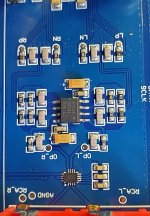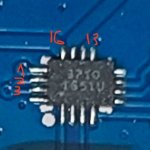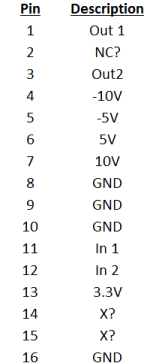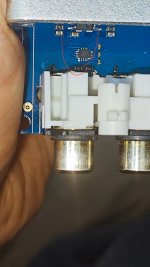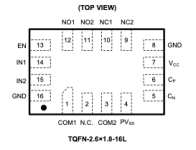Reviving the thread as I too am looking for help with the same part. My Topping E30 stopped producing sound and I have narrowed down the issue to this chip.
I spent quite a bit of time trying to identify the part, but with no success. This included browsing on Mouser, filtering by function and based on package and checking quite a few datasheets, but none seem to match this chip so far (but equally given the vast number of choices I cannot be sure I have not missed/filtered out something).
What I came up with about the chip so far:
- analog switch, at least 2 channels (unlikely to have more based on pinout...)
- QFN-16 package (wide), 4 pins each side
- SMD code 3710 (second row seems to be date code, my chip has 1807U, original poster shows pictures with 2007U, I've seen online pictures with 1707U)
I'm attaching a picture of the relevant area from my DAC.
Pinout based on how it's used on E30:

I spent quite a bit of time trying to identify the part, but with no success. This included browsing on Mouser, filtering by function and based on package and checking quite a few datasheets, but none seem to match this chip so far (but equally given the vast number of choices I cannot be sure I have not missed/filtered out something).
What I came up with about the chip so far:
- analog switch, at least 2 channels (unlikely to have more based on pinout...)
- QFN-16 package (wide), 4 pins each side
- SMD code 3710 (second row seems to be date code, my chip has 1807U, original poster shows pictures with 2007U, I've seen online pictures with 1707U)
I'm attaching a picture of the relevant area from my DAC.
Pinout based on how it's used on E30:
Attachments
Where are the communication line(s) for the chip ?
You know there must be something controlling it...
I read 3710 (Q?) and 1807U
You know there must be something controlling it...
I read 3710 (Q?) and 1807U
TI OPA 1612 is a "SoundPlus™ Audio Operational Amplifier".Topping E30 stopped producing sound and I have narrowed down the issue to this chip.
- analog switch, at least 2 channels (unlikely to have more based on pinout...)
- QFN-16 package (wide), 4 pins each side
Which is certainly a likely thing in this application.
I don't think I have seen ANY op-amp just die (since I killed all the RCA '709s) (and commodity opamps run on +/-22V for years).
Communication/enable line(s) can be only pins 14/15 and potentially 2, given that the rest of the pins have different functions. At second thought, pin 13 could also be enable pin (rather than 3.3V DC in), but not very likely. In any case, most of the pins have been characterized already - normally this should be more than enough to identify the chip from a short list of candidates.Where are the communication line(s) for the chip ?
You know there must be something controlling it...
Indeed, that's exactly what I mentioned in my original post. It is certainly 3710 rather than 371Q, picture attached is not that clear when it comes to this, but having checked the chip under the microscope I'm sure the last character is number 0. Note that 1807U is the date code.I read 3710 (Q?) and 1807U
I'm not sure I get your point... Op-amp does work and I have signal at the output of OPA1612 / before the electronic switch chip. I do not have signal after the muting switch. Hence my earlier comment that the issue is with this unknown QFN-16 switch chip (and not the SOIC-8 OPA1612).TI OPA 1612 is a "SoundPlus™ Audio Operational Amplifier".
Which is certainly a likely thing in this application.
I don't think I have seen ANY op-amp just die (since I killed all the RCA '709s) (and commodity op-amps run on +/-22V for years).
As an aside (since this is not what happened here), I for one have experienced op-amps "just" dying. Most recent one only a couple of weeks ago, as luck would have it in another Topping product. Of course, it depends on the definition of "just", but let's say I was not able to identify the root cause (stable power supply and within specs, no funky business with the input signal or the load - not per my knowledge at least, proper decoupling and no oscillations noted prior to the incident etc.).
If you are sure that it is the mute relay at fault why don't you bypass it and see what happens.
The mute switch is at fault, and this is an established fact since there is signal before the switch IC but not after. Bypassing it will bring signal to the RCA output, no doubt about that. It will however mean that there will be pops and clicks when turning the DAC on/off, when sample rate changes or when signal format is switched between PCM and DSD. Which is not a trade-off I am willing to put up with, hence trying to identify and source the IC so that I can replace the defective one.If you are sure that it is the mute relay at fault why don't you bypass it and see what happens.
A mute IC, that is new to me. Must be to replace those unreliable/expensive relays 🙂 Seriously, is it just for power on/off plops or also for other errors?
Mute transistors were all over cassette decks.A mute IC, that is new to me.
A mute IC:
https://datasheetspdf.com/pdf/319434/TOKO/TK15125/1
https://cdn.datasheetspdf.com/pdf-down/T/K/1/TK15125_TOKOInc.pdf
I don't see a place to buy one. (Also wrong package.)
So it is the SGM3710 as mentioned in another thread: http://www.visvie.com/static/upload/file/20220121/1642747164583685.pdf
I would not hesitate to remove these and simply connect the PCB tracks*. A small extra PCB with "shorting to GND" with a single Omron G6K for power on/off and things are back to normal. Those unreliable relays seem more reliable than semis (again).
*As these SGM3710 seem to break down more often replacing them for the same IC seems futile. It als contains a charge pump as usual and maybe one does not want too much of those in the chain (debatable).
I would not hesitate to remove these and simply connect the PCB tracks*. A small extra PCB with "shorting to GND" with a single Omron G6K for power on/off and things are back to normal. Those unreliable relays seem more reliable than semis (again).
*As these SGM3710 seem to break down more often replacing them for the same IC seems futile. It als contains a charge pump as usual and maybe one does not want too much of those in the chain (debatable).
So it is the SGM3710 as mentioned in another thread: http://www.visvie.com/static/upload/file/20220121/1642747164583685.pdf
This is it indeed, thank you!
Was not aware of this question having been answered previously (although I had seen it being asked in other forums/threads), but indeed when searching by SGM3710 I find at least one thread discussing about this chip in the context of Topping products.
Strictly speaking it is not a muting IC, rather an analogue switch IC used for muting function in this circuit (NB: disconnect the output rather than shorting to ground via a resistor).A mute IC, that is new to me. Must be to replace thoseunreliable/expensive relays 🙂 Seriously, is it just for power on/off plops or also for other errors?
Some sort of muting circuit is needed for AK449X DAC chips as they produce pops/clicks when format or sample rate of the audio stream changes; that is on top of addressing the on/off pops.
As a general rule I too prefer relays, but it really depends on the application. In this particular case I think Topping engineers found a good compromise, SGM3710 does the job and without performance penalty (E30 measures very well, with THD+N very close to the limit set by AK4493). Maybe less reliable (not easy to know without having all the data) but in the same time relays are known to break down as well. The charge pump would be better avoided all else being equal, but again measurements for E30 would indicated this is not an issue in this case.
Doable but probably messy given the difference in size/footprint.I would not hesitate to remove these and simply connect the PCB tracks*. A small extra PCB with "shorting to GND" with a single Omron G6K for power on/off and things are back to normal. Those unreliable relays seem more reliable than semis (again).
A relay would likely be more reliable if done properly, I do not disagree. But some may be put off by the constant relay clicks if their playlist is made up of files with various sampling rates or formats (PCM vs. DSD).
In my particular case, I'd rather keep it simple and replace the IC (which thanks to you I am now one step closer to achieve), in particular since this DAC is not in my main system and it is not used frequently.
Disconnecting/connecting outputs is IN the signal path so worse than shorting outputs via 100 Ohm to GND. The challenge is, regardless of stellar measurements, to hear the difference between semiconductor muting and simple contacts. That SGM3710 seems to break down a lot more than simple microrelays used for the noble task of muting (= almost 0 current). With regards with clicks and plops: I have AM4490EQ here and no muting/switch IC AFAIK but I will look again. So to me the SGM3710 solution is the odd solution and also an unreliable one.
Messy is entirely up to you, 2 thin copper wires from a stranded cable look OK and won't fail. Don't complain when the second set SGM3710 (if you can find it, it seems a hard to find IC) breaks down and the PCB tracks peel off and stick to the soldering tool 🙂
Tip: connecting and disconnecting cables is best done when both devices are deenergized.
Messy is entirely up to you, 2 thin copper wires from a stranded cable look OK and won't fail. Don't complain when the second set SGM3710 (if you can find it, it seems a hard to find IC) breaks down and the PCB tracks peel off and stick to the soldering tool 🙂
Tip: connecting and disconnecting cables is best done when both devices are deenergized.
Last edited:
those are caps not resistors. you can tell from the colorCan you see the 0805 resistors in the picture?
I have access to this picture, not sure which one are you seeing:
https://www.diyaudio.com/community/attachments/20211227_122531-jpg.1009197/
Did you end up buying the chip? I was barely able to identify it, but with the help of deep dive openai function and some other descriptions, it led me right to here. Indeed this is the chip that I have. I think this is at fault in my DX3 pro+, because I was playing with my messy amplifier that I am modifying and I think I fvcked something up. I'm suspecting this chip. I can still hear output on max DAC output but it's very silent. However I have put an adapter into the headphone out and the routed my RCA cables and it works just fine. But I suppose the headphones have additional amplification stages that makes the sound worse.Doable but probably messy given the difference in size/footprint.
A relay would likely be more reliable if done properly, I do not disagree.
Well, anyway, I'm thinking of either short circuiting this chip once I figure out how, or ordering and trying to solder it in (for which I would probably need hot air soldering kit, this thing is tiny).
Anyway, I'm curious what you ended up doing.
OP, is this the correct interpretation of the pinout of my chip?
If so, can I just connect the pin 1 to pin 11 ; pin 3 to pin 12 and call it a day?(given that I don't care about turn on thumps cracks and so on, I'd rather do that than try to solder this tiny chip which I cannot even buy)
I suppose you were able to find the E30 schematic, I was in no such luck with my DX3 pro+.
If so, can I just connect the pin 1 to pin 11 ; pin 3 to pin 12 and call it a day?(given that I don't care about turn on thumps cracks and so on, I'd rather do that than try to solder this tiny chip which I cannot even buy)
I suppose you were able to find the E30 schematic, I was in no such luck with my DX3 pro+.
Attachments
Last edited:
Never mind the last picture, apparently the most left on the bottom is the first indicated by the white dot above it. The rest goes counterclockwise around the chip.
Well I connected pin 11 to pin 1 and pin 12 to pin 3 but didn't get an output at RCA, so maybe one of my OPamps is burned?
Attachments
http://www.visvie.com/static/upload/file/20220121/1642747164583685.pdf
Is the IC still there? If so you maybe should remove it as it is defective.
Edit: wrong pins! Your device has the TQFN package.
Is the IC still there? If so you maybe should remove it as it is defective.
Edit: wrong pins! Your device has the TQFN package.
Attachments
Last edited:
I had reached out to Topping and they were open to sell me some SGM3710. But as luck would have it, a few days later my E30 started working on its own (!?). I was never able to find out what had happened with the SGM3710 and how come it recovered, but that's another story.Did you end up buying the chip? I was barely able to identify it, but with the help of deep dive openai function and some other descriptions, it led me right to here. Indeed this is the chip that I have. I think this is at fault in my DX3 pro+, because I was playing with my messy amplifier that I am modifying and I think I fvcked something up. I'm suspecting this chip. I can still hear output on max DAC output but it's very silent. However I have put an adapter into the headphone out and the routed my RCA cables and it works just fine. But I suppose the headphones have additional amplification stages that makes the sound worse.
Well, anyway, I'm thinking of either short circuiting this chip once I figure out how, or ordering and trying to solder it in (for which I would probably need hot air soldering kit, this thing is tiny).
Anyway, I'm curious what you ended up doing.
If in your case SGM3710 is indeed damaged, it would be quite difficult to replace it without a hot air station or as a minimum a hot plate.
- Home
- Design & Build
- Parts
- What type of solid state relays are these ?
